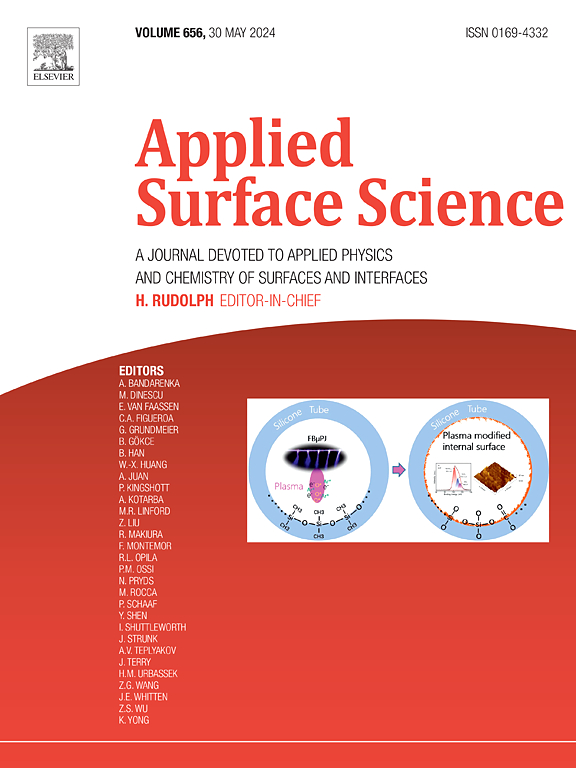WS2-Si3N4 纳米孔阵列-银膜异质结构中的激子-光子耦合大幅增强
IF 6.9
2区 材料科学
Q2 CHEMISTRY, PHYSICAL
引用次数: 0
摘要
二维过渡金属二硫族化合物(TMD)单层由于其激子结合能特别大而被认为是实现强耦合的一个有前途的平台。已经提出了各种类型的光学共振,包括基于dbr的Fabry-Perot共振、等离子体共振、Mie共振和导模共振,以促进TMD单层中激子与光学纳米腔之间的强耦合。然而,对于TMD单层中多共振与激子之间的强耦合,目前的研究还很有限。在这项研究中,我们提出了一种由WS2- si3n4纳米孔阵列和Ag膜组成的异质结构,以实现WS2单层中表面横向波导模式、表面晶格共振(或导模共振)和激子之间的强耦合。这种杂化异质结构继承了Si3N4光子晶体板表面晶格共振的优点,并在介电-银界面处具有表面等离子体模式,从而产生低损耗的光学共振和优异的场约束。因此,WS2单层中表面横波导模式、表面晶格共振和激子之间的光-物质相互作用显著增强。利用角分辨散射光谱测量和数值模拟,我们观察到大量的拉比分裂和共振峰位移,这表明了混合模式耦合。实验结果与模拟结果吻合较好,从而证实了表面横波导模式、表面晶格共振和激子的混合耦合。值得注意的是,我们发现Rabi分裂(耦合强度的一个指标)显著增加到318 meV,从而在三振子框架内进入强耦合状态。这些结果不仅加深了对介电光子结构中混合模式相互作用的理解,而且促进了高性能光电应用的进步。本文章由计算机程序翻译,如有差异,请以英文原文为准。


Greatly enhanced exciton-photon coupling in a WS2-Si3N4 nanohole array-Ag film heterostructure
Two-dimensional transition metal dichalcogenides (TMD) monolayers are recognized as a promising platform for realizing strong coupling due to their exceptionally large binding energies of excitons. Various types of optical resonances, including DBR-based Fabry-Perot resonances, plasmonic resonances, Mie resonances, and guided mode resonances, have been proposed to facilitate strong coupling between excitons in TMD monolayers and optical nanocavities. However, there has been limited research on the strong coupling between multiple resonances and excitons in TMD monolayers. In this study, we propose a heterostructure composed of a WS2-Si3N4 nanohole array and an Ag film to achieve robust strong coupling among surface transverse waveguide modes, surface lattice resonances (or guided mode resonances), and excitons in a WS2 monolayer. Such a hybrid heterostructure inherits both advantages of surface lattice resonances in a Si3N4 photonic crystal slab with the surface plasmon-like modes at the dielectric-Ag interface, resulting in low-loss optical resonances and excellent field confinement. Consequently, the light-matter interaction among the surface transverse waveguide mode, surface lattice resonances, and excitons in the WS2 monolayer is significantly enhanced. Utilizing angle-resolved scattering spectra measurements and numerical simulations, we observe substantial Rabi splitting and shifts in resonant peaks, which are indicative of hybrid mode coupling. The experimental results closely align with the simulations, thereby confirming the hybrid coupling of the surface transverse waveguide mode, surface lattice resonances, and excitons. Notably, we show that Rabi splitting, an indicator of the coupling strength, is significantly increased to 318 meV, thereby entering the strong coupling regime within a three-oscillator framework. These results not only deepen the understanding of hybrid mode interactions within dielectric photonic structures but also promote advancements in high-performance optoelectronic applications.
求助全文
通过发布文献求助,成功后即可免费获取论文全文。
去求助
来源期刊

Applied Surface Science
工程技术-材料科学:膜
CiteScore
12.50
自引率
7.50%
发文量
3393
审稿时长
67 days
期刊介绍:
Applied Surface Science covers topics contributing to a better understanding of surfaces, interfaces, nanostructures and their applications. The journal is concerned with scientific research on the atomic and molecular level of material properties determined with specific surface analytical techniques and/or computational methods, as well as the processing of such structures.
 求助内容:
求助内容: 应助结果提醒方式:
应助结果提醒方式:


